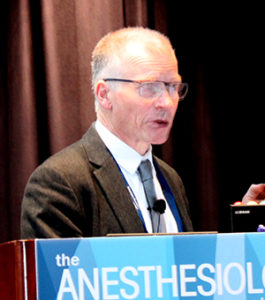
Lars S. Rasmussen, M.D., Ph.D., discusses the use of oxygen to treat and prevent hypoxemia.
Oxygen administration is critical to treating surgical patients with hypoxemia, but should it be used for patients with other conditions, such as cardiac arrest, acute MI or stroke?
According to speakers at “Oxygen? Who Needs It and Why” Saturday, oxygen is beneficial in treating and preventing hypoxemia, but it can lead to complications in patients with other conditions and should not routinely be used intraoperatively.
“Medicine and the work that we do aim to ensure that the brain and vital organs receive oxygen,” said Vivek Moitra, M.D., Associate Professor of Anesthesiology at the Columbia University Medical Center in the Division of Critical Care, Chief of the Division of Critical Care in the Department of Anesthesiology and Medical Director of the Cardiothoracic and Surgical Intensive Care Units.
“We can only conquer disease if we know how to get oxygen from the atmosphere to mitochondria. Oxygen travels through the body to the cell down an oxygen cascade. Along the way, there will be obstacles that will reduce the partial pressure of oxygen. Our goal as anesthesiologists is to identify the times when we know that oxygen is diluted, when we’re convinced that oxygen is extracted and when we find oxygen meets a roadblock,” Dr. Moitra said.
Normoxia in humans means 21 percent oxygen in the brain. Anything above that level, or hyperoxia, can be harmful to patients. The delivery of oxygen (DO2) to the blood is the amount of oxygen in the blood determined by the hemoglobin concentration and the arterial oxygen saturation multiplied by the cardiac output, he said.
“Among the determinants of DO2, cardiac output is probably the most important. Indeed a fall in hemoglobin or oxygen saturation can be compensated for by an increase in cardiac output, but the opposite is not true,” Dr. Moitra noted.
Oxygen is as much food for us as fruit or vegetables, he said. The average human consumes about 1.4 pounds of food per day and 500,000 cc of oxygen daily — or 1.5 pounds of oxygen — to stay alive.
“But in shock states where venous saturation is low from increased oxygen extraction, venous blood will require more exposure to oxygen to reach a saturation of 100 percent. If these patients’ lungs are injured, oxygenation may be problematic and arterial desaturation will follow,” Dr. Moitra said.
Lars S. Rasmussen, M.D., Ph.D., Professor of Emergency Medicine and a Consultant in Anesthesia at the Center of Head and Orthopaedics at the Rigshospitalet, University of Copenhagen, Denmark, said that oxygen should be used to treat and prevent hypoxemia, but that a high inspiratory oxygen fraction may be associated with complications.
“There is no firm evidence that a high oxygen fraction should be used as a routine intraoperatively or in critical situations other than hypoxemia,” Dr. Rasmussen said.
The use of high oxygen fraction has been suggested to reduce surgical infections postoperatively, he said. However, the randomized PROXI clinical trial of the effects of using high perioperative oxygen fraction on surgical site infection and pulmonary complications after abdominal surgery showed that the administration of 80 percent oxygen compared with 30 percent oxygen did not result in a difference of surgical site infection after surgery.
A separate study of the use of high oxygen fraction in the resuscitation of cardiac arrest patients showed that patients given high oxygen fractions had higher mortality rates. Consequently, normal oxygenation should be used for these patients, Dr. Rasmussen said.
Other studies have shown no benefit in using high oxygen fraction for acute myocardial infarction patients or stroke patients, he said.
Return to Archive Index